‘The Art of Swimming. Illustrated by proper figures. With advice for bathing. By Monsìeur Thevenot. Done out of French. To which is prefixed a prefatory discourse concerning artificial swimming, or keeping ones self above water by several small portable engines, in cases of danger.”

Students of the 1696 book the Art of the Swimming might not win races, but they will be better prepared to survive a shipwreck and know how to their toenail whilst not-downing.
“While one reflects on those many and frequent Accidents, which thro’ want of Swimming daily happen amongst us: Every one is ready to complain of the unhappiness of Man in that respect, in comparison of other Animals, to whom Nature has indulg’d that faculty, which he ought to enjoy in a more excellent degree, since it is so necessary to his Preservation.
But if we thoroughly consider the business, we shall find nothing more unreasonable than that complaint, since without doubt Man would not only Swim naturally like other Creatures, but also in more Perfection, and with more Variety, both for Pleasure and Advantage; otherwise there would not so many acquit themselves that way with such and admirable dexterity and address, as we daily see, which sufficiently demonstrates, that Man has naturally all those Dispositions which are requisite and necessary for it. [..]
This Art, which may be numbered among the Mechanick ones, since it is performed by Motion, and the Agitation of the Hands and Feet, has been hitherto exercised rather by a rude Imitation, than the Observation of any Rules or Precepts, by reason no on has taken the pains to reduce it to any; although it has always sufficiently deserved it, by the great advantages it brings to those who possess it, and in general to all Civil Societies, the consideration whereof ought to have made Men study to render it more easy to be learned, and more familiar to all men, since they may have so great occasion for it. [..]
To mention some few advantages of Swimming. In case of Shipwreck, if one is not very far from Shore, the Art of Swimming may set one safe there, and to save from being drowned. In case of being pursu’d by an Enemy, and meeting a River in ones way, you have the advantage of escaping two sorts of Death, by gaining the Shore on the other side, and so escaping from your Enemy, and from being drowned in the attempt of doing it.
But a good Swimmer may not only preserve his own Life, but several others also. An open vessel on the main sea, in a Storm may be kept from sinking by a good Diver; Or having lost her Anchors and Cables, and being ready to be cast on the Shore, may by him be haled thither, and avoid being dashed against the Rocks, and so the Lives of all in it saved; and the occasions of being thus helpful are only too frequent, as those who are used to the Seas very well know. By the same means one may attack an Enemy posted on the adverse sides of Rivers, and thereby sometimes gain a Victory. [..]
Before you go into the water, you ought to see that it be clear, that there be no scum or froth on the surface, what sort of bottom it has, that there be no weeds or mud, for one’s feet may be entangled among the weeds, or one may sink into the mud, and the water coming over one’s head, remain there, and be drowned.
Something yet remains to be observed before you enter into the water, in regard to stripping yourself. If you sweat when you come to the place you have chosen; or if you have sweat some time before you came, and are not quite cooled, you ought to strip by degrees, and that by walking to and fro on the shore, so that you may recover a good temperature, and by thus gradually stripping, the pores have leisure to close, and the body become in good condition, to be exposed to the air without any detriment to the health. After which you may enter into the water, and Swim according to the following precepts.”
– Melchisédec Thévenot in the introduction to ‘L’Art de Nager’ (1696) (1699 translation)

Of the manner of entring into the water
“There are some who after a short Race fling themselves into the Water on their Right or Left side, as in Figure 4. Others taking several Leaps towards the Bank of the River, at last Leap in with their Feet foremost, Body upright, meeting the Water first with their Buttocks and Calves of their Legs, as in figure 5. This way is very safe and the best of all.”
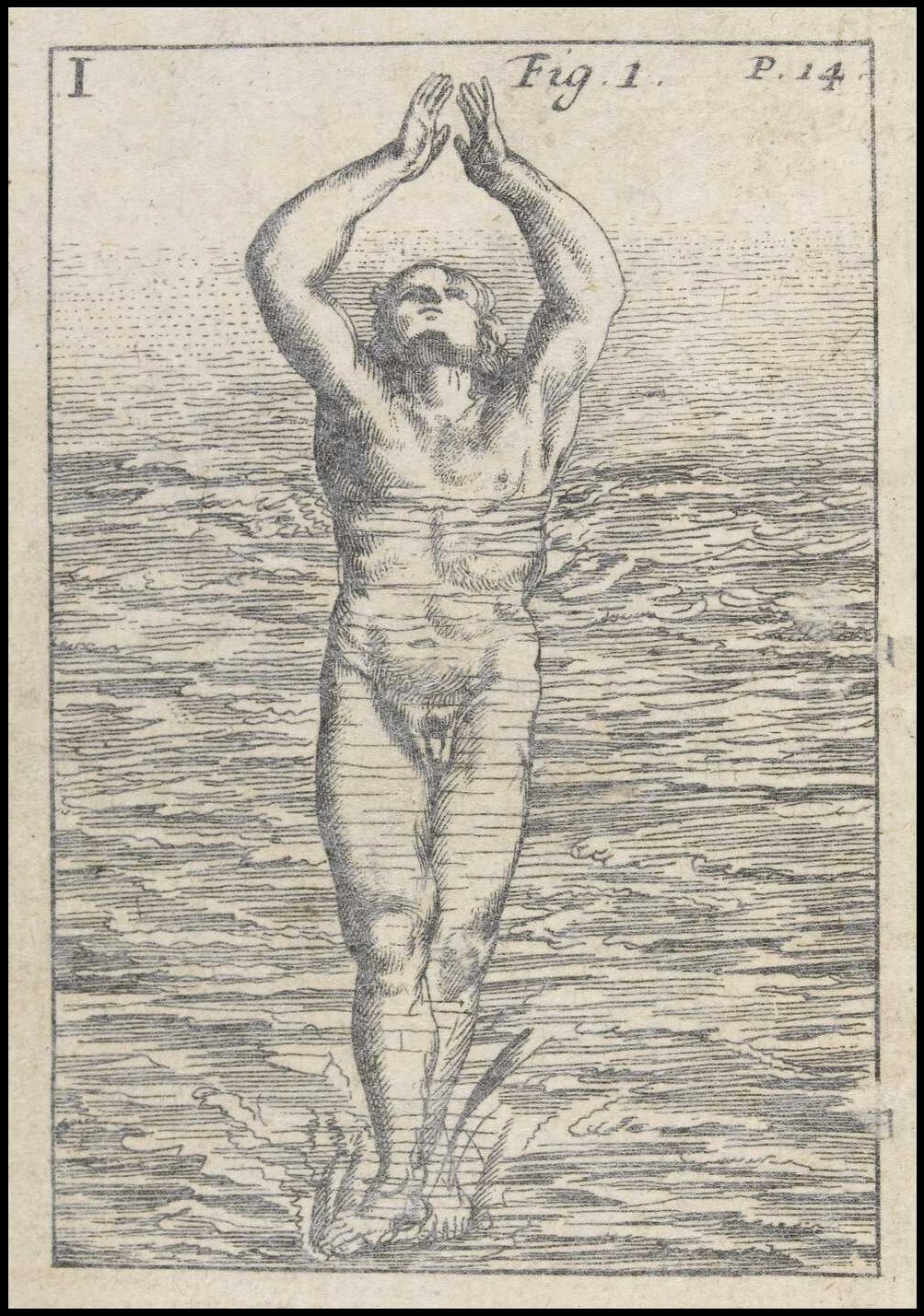
Of the manner of entring into the water (3)
“Those who don’t know how to Swim, ought to enter by degrees, and gently into the Water; but those who are expert oftentimes leap in all at once with their Feet perpendicular to the Bottom, as is represented in the first Figure.”

To Sit in the Water
“Expert Swimmers can do whatever they please in the water; they can walk there, stand still upright, or lye still or sit down. To sit, you must take both your Legs in your Hands, draw in your Breath, and so keep your Breast inflated; your Head upright, and lifting up successively your Arms and Legs by that motion sustain your self.”
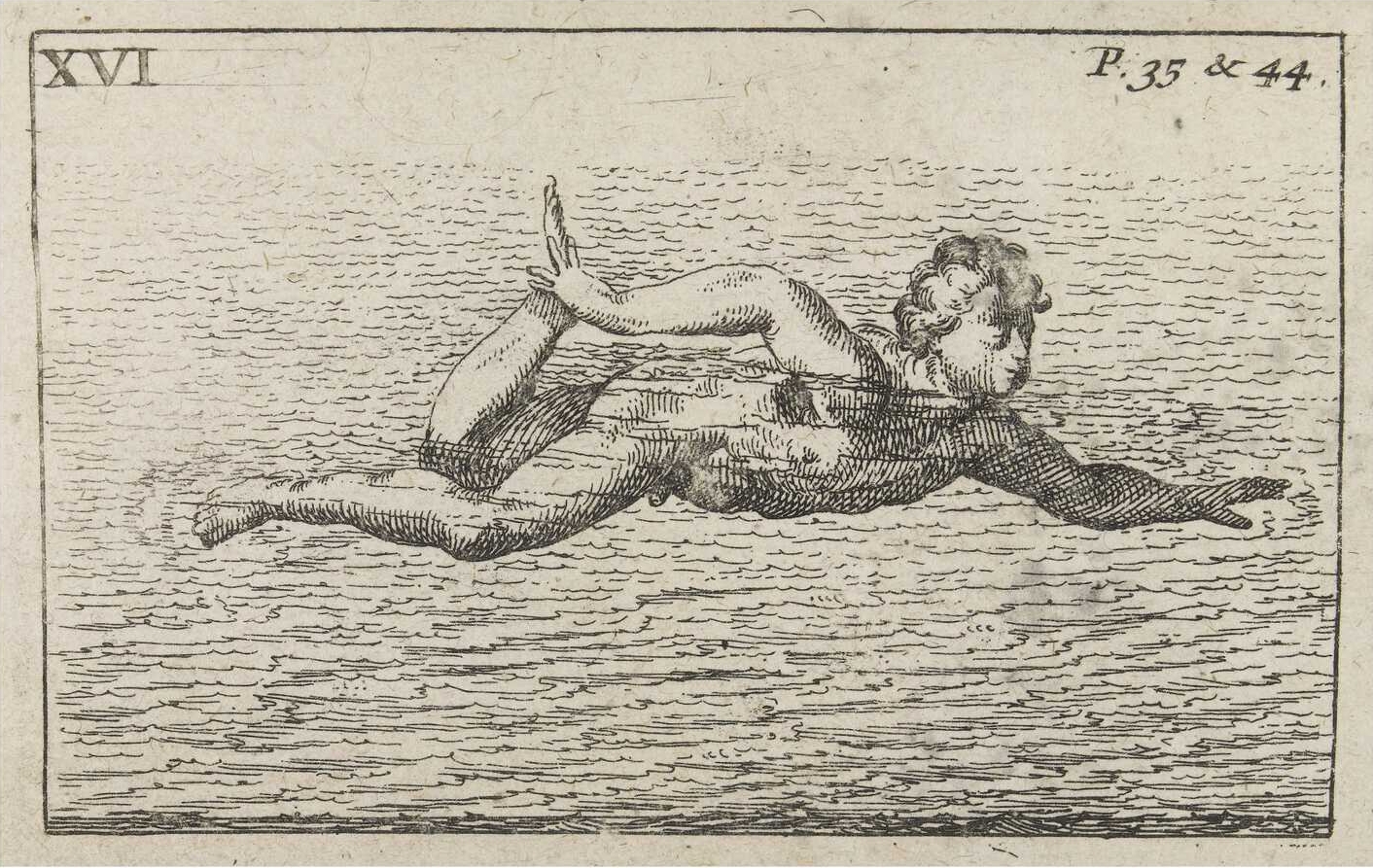
“To carry the left leg in the right hand’

To tread Water
“By this way you remain upright in the water without making any motion with the hands, only you move the water round with your Legs from you, the Soals of your Feet being perpendicular to the bottom; you may make use of this if you are cast into the water bound hand and foot.”

To cut the Nails of the Toes in the Water
“It is possible to perform actions in the Water, which one cannot do on Land; I my self have often brought my Great Toe to my Lips in the Water, which I could never do on Land, not on my bed. You must hold your knife in your right hand (if you are right-handed) and take up your left Leg, and lay the Foot on the right Knee; there you make take if from the left hand, and with the right cut your Nails without any danger. Thus you may also pick your Toes; and if this way has no other use or advantage, yet the dexterity of the management may serve to recommend it.”
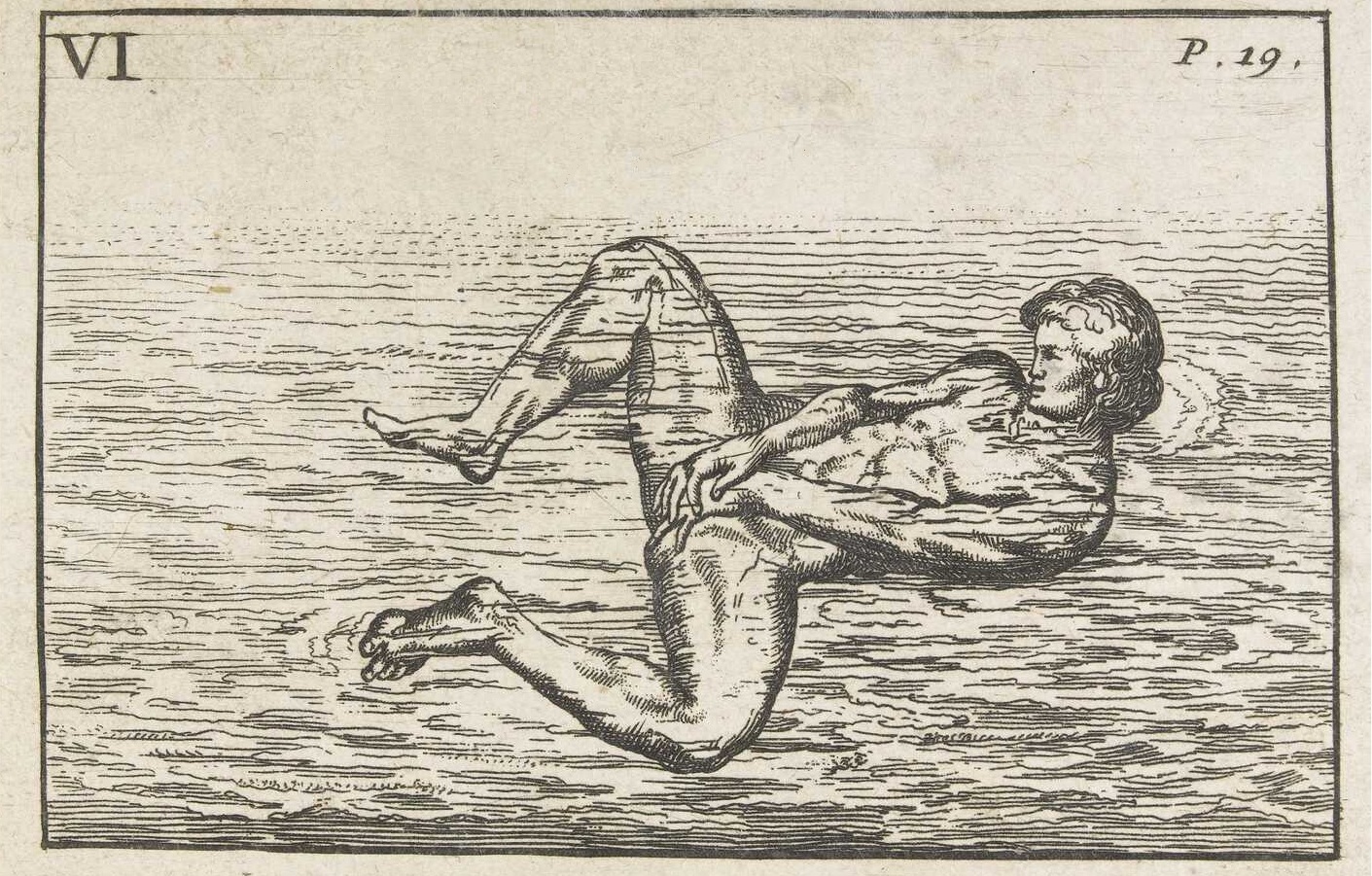
To swim with head erect towards heaven
“This way seems difficult, though it imitates the Posture they say is natural to Man, to look upwards; and if we knew how to make use of it, there would not be so many drowned as there daily are; for that happens, because, instead of looking upwards, they look downwards with their heads towards the bottom, and embrace the water, as it were with their arms, insomuch that one might say they did all they could on purpose to drown themselves.“If they would place themselves on their backs, and keep their bodies extended, they might easily escape, nay could not sink themselves in that posture if they would; this we find attested by experience; and I never yet met with any diver that could possibly descend in that posture, that is, with the head erect towards Heaven; and if they had a mind to it, they found themselves first obliged to elevate their arms upright to contract their thorax or breast; and when all this is done, find it very difficult to sink, though very slowly, and always come to the bottom with their feet first.”

To Swim on the belly holding both your hands still
“This is easily performed in the manner following. You must keep your Breast advancing forward, your Neck upright on the water, both your Hands fast behind your Head, or on your Back, while in the mean time your Legs and Thighs push you forward by the same motions you make when you Swim (as at other times) on your Belly. This way of Swimming may be useful, in case any accident, as the Cramp, &c. should happen to your Arms, or if you were forced on occasion to Swim with your Hands tyed behind you, on in case you were a Prisoner, and your Life or Liberty depended on it.”
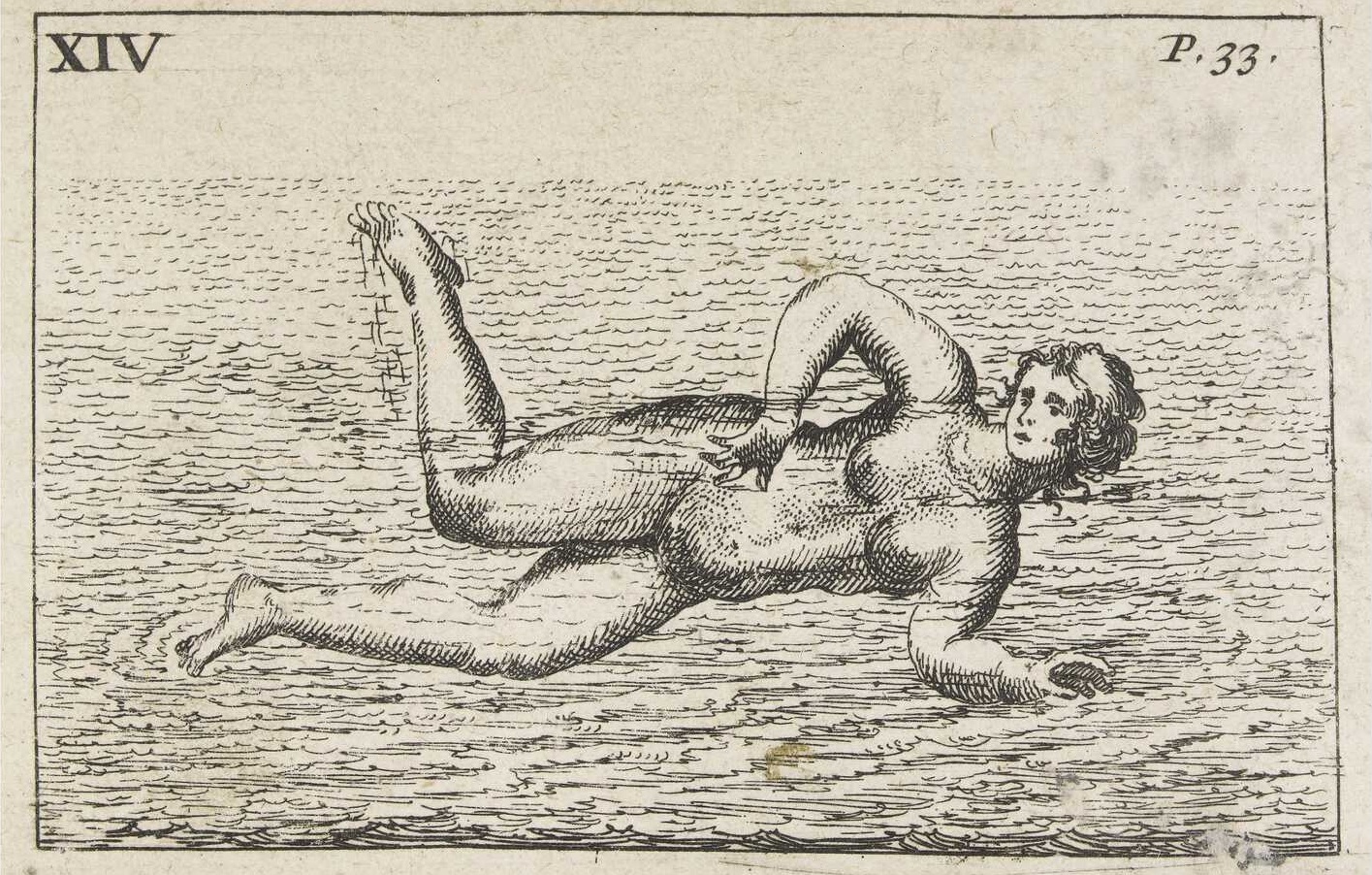
To swim neither on back, nor belly
“Suppose you Swim on your Back, or Belly, lower of sink your left side, and at the same time elevate your right one. In Swimming, when you are thus laid, move your left hand as often as you see convenient, without either separating it far from your Body, or sinking it, perpetually striking it out and retracting it, as in a right line on the surface of the water. Besides the pleasure of swimming thus, you may also find an advantage by viewing as you please either side of a River, and that one side may rest while the other is employ’d.”
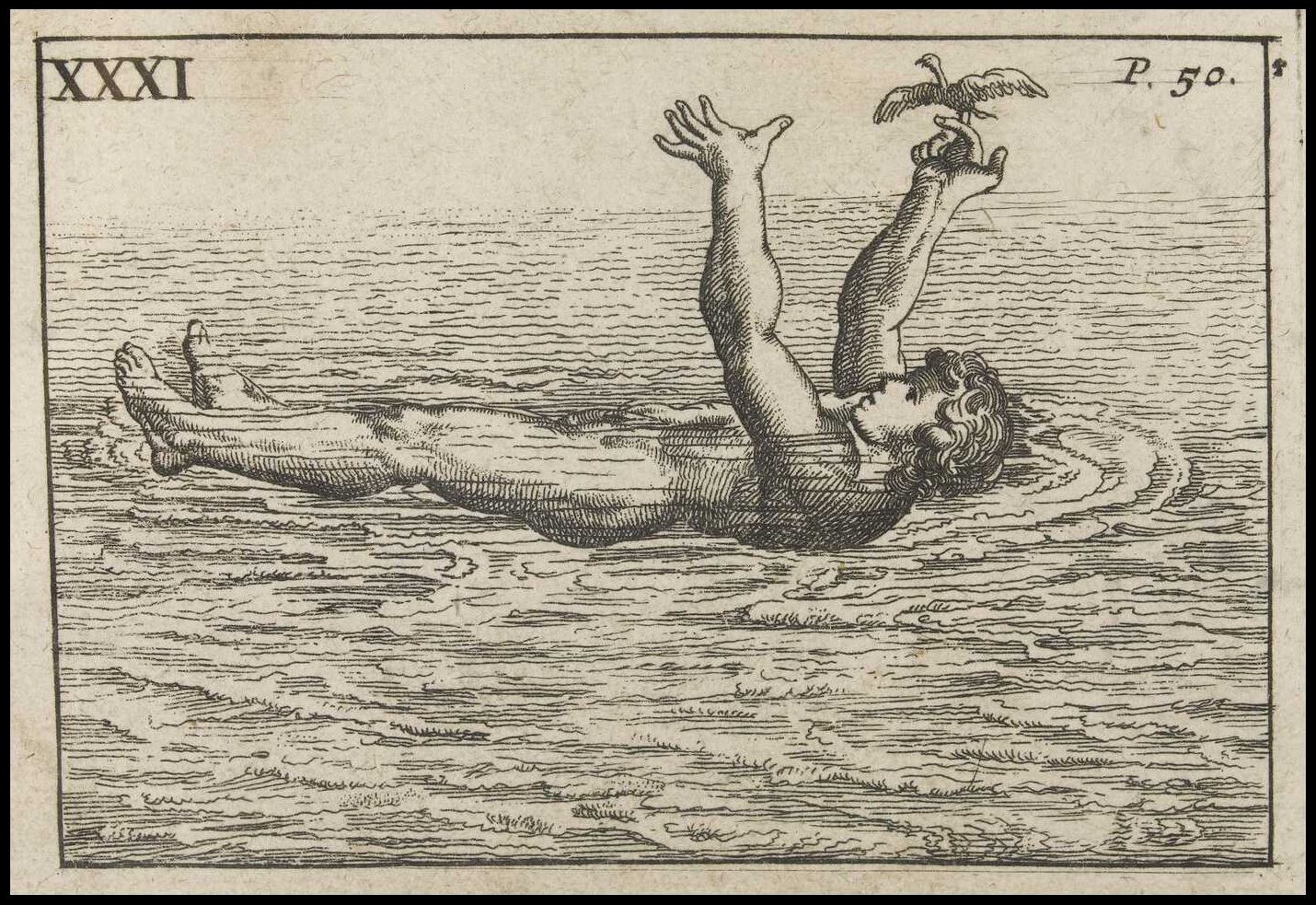
To Swim holding up the Hands
“While you Swim on your Back it is easie to put your hands to what use you please, but it is difficult to hold them upright, and Swim at the same time too. It would appear at first sight as if this were the most easy method we have yet taught. You must take care lest while you lift up your arms, the thorax or breast be not contracted, for so you sink. The whole art of this way of Swimming consists in heaving up the breast as high, and keeping it inflated as much as possible, while your arms are held up.”

In swimming under water to make a circle
“When Swimmers go to search for any thing in the water, they Swim round about the place where the thing was cast in, if they do not find it immediately; by this sort of address they can take up any the least thing that is at the bottom.The manner of making this compass or circle is thus: if you would begin in the Circle from the right hand, and end it at the left, you must grasp or embrace the water with both your hands from the right to the left, and exactly contrary if you would turn the other way; but when you have Dived perpendicularly down, and can’t find what you went to seek, you will be obliged to take such a compass, but don’t go so far as to lose the light; for when once that begins to fail you, it is a sign that you are either too deep, or under a Boat, or Shore, or something else that intercepts the light.
You must always take heed of venturing into such places; and if you should find yourself so engaged, call to mind whereabouts, or which way you came thither, and turn back the same way, looking upwards for the light: for you may see it a great way off: above all, take heed you don’t go to breathe under water: In case you are afraid of any Enemy that should lay wait for you when you come up again, you must have recourse to the Agility of the Dolphin.”
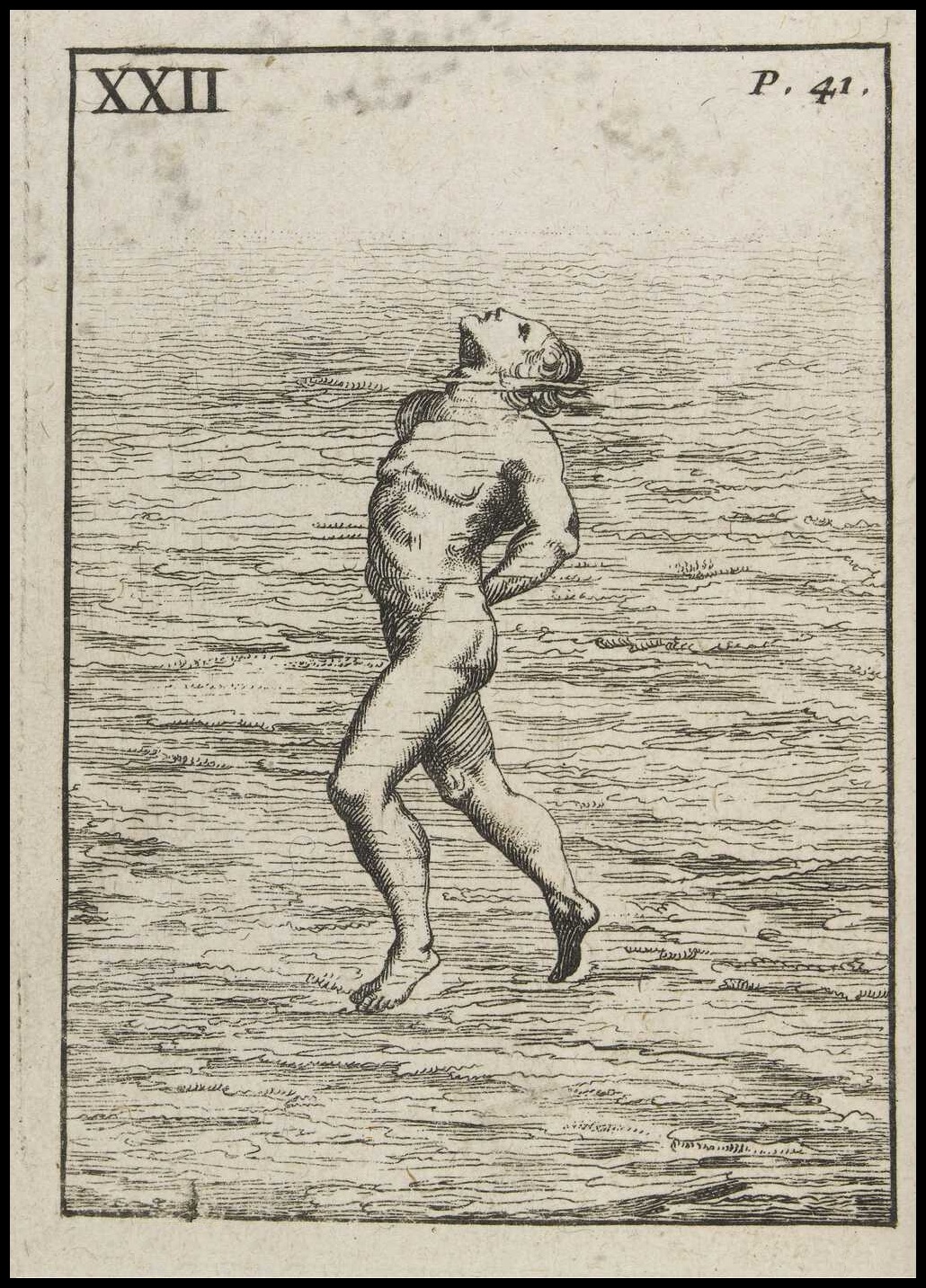
Suspension by the chin
“You cannot easily imagine how this manner of Swimming is performed, it is indeed very surprising. By this means you may stand upright in the water though never so deep, without fear of sinking.“To make you comprehend it, you are to remember that when you Swim on your back, you lye still, your Legs being extended: When you find yourself in that posture, you must let your legs go down, or sink; and when they come to be perpendicular to the bottom, you must take them up again, bending your knees, inflating your Breast, and as to the Arms and Hands whereof the back-parts lye flat on the water by the shoulders, you must sometimes extend them on the one side, sometimes on the other, sometimes shut them, turning the Palms towards the bottom, the fingers close to one another, holding your Chin upright as possible.
“This way which seems so surprising, is sometimes very useful; suppose at any time, the Ice should happen to break under your Feet, this way will be of vast advantage to secure yourself from the danger. It may also be very advantageous in case a man is obliged to save himself from some enemy pursuing, by leaping into the water in a dark night; for in that case, one may wait, without making any noise, till he is passed by, then go again on shore.”

To Boot ones self in the Water
“I call this way by the name of Booting or drawing on ones Boots, because the action very much resembles a Man doing so. You must first lift up one leg out of the water, and afterwards the other, and take the foot in your hands as those do who are drawing on their boots, and presently after let it go again, exending it out at length. The management of this way consists in keeping up your breast as high as you can, and as much inflated as possible, and also the one leg up out of the water while the other is continually playing downwards. This way may be very commodious for cleaning your Feet from mud.”

The Perpendicular Descent
“This is proper for those who leap off from any height into the water, as from a Bridge or Ship: This is performed by taking a little leap forwards, and sometimes upwards, that your descent may be more perpendicular, or swifter to the bottom, and also that your head may go perpendicularly downwards. This way is very Commodious, when you have a very deep water, and it cannot be performed after any more ready method, because of the difficulty of holding ones breath.”

To come to the top of the water again, after having dived
“After you are at bottom, you may return with the same facility; which is performed much after the same way as we have taught before, to turn ones self in the water; the person who swims with one of his hands extended, must push from him the water before him with the palm, and with the cavity of the other palm drawing the water that is behind him, towards him; when your hand is extended as far as it can be, the fingers of the hand so extended, and the palm of that turned outwards, ought to shut or clench: the perfection of this way you’ll see [..].”

To Dive
“If Men sink to the bottom of the water, it is their own fault, nature has laid no necessity on ’em doing so; nay there is not only occasion for force and strength to come thither, but also Art to do is safely, speedily and handsomely, but those that are expert at Swimming do it, on occasion, as swift as an Arrow, and descend perpendicularly or obliquely as they please.”

To shew out of the Water, four parts of the Body
“This manner shews at once four parts of the Body, viz. the Head, the two Elbows, and one Knee… Besides the management of this method, and the difficulty of doing it well, it is serviceable to rest your self by putting on Thigh across the other, and to take breath where the water is so deep that you cannot reach the bottom.”

Via: Bibliodyssey
Would you like to support Flashbak?
Please consider making a donation to our site. We don't want to rely on ads to bring you the best of visual culture. You can also support us by signing up to our Mailing List. And you can also follow us on Facebook, Instagram and Twitter. For great art and culture delivered to your door, visit our shop.






